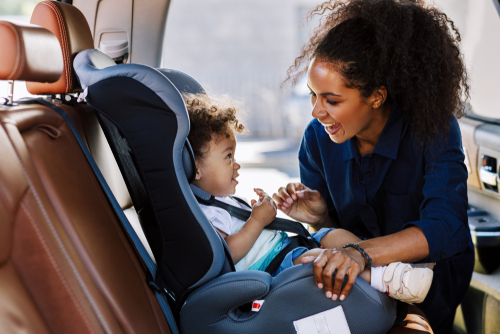
Car seats and boosters provide protection for infants and children in a crash, yet crashed are a leading cause of death for children ages 1 to 13. That’s why it’s so important to choose and use the right car seat correctly every time your child is in the car. Follow these important steps to choose the right seat, install it correctly and keep your child safe.
Find the right car seat
Car Seat Types
Learn about the four types of car seats, while keeping in mind the following tips:
- As children grow, how they sit in your car will change. Make sure you use a car seat that fits your child’s current size and age.
- Not all car seats fit in all vehicles. Make sure the car seat is the right fit for your vehicle (PDF, 1.77 MB). Test the car seat you plan to buy to make sure it fits well in your vehicle.
- Buy a car seat that can be installed and used correctly every time.
Rear-Facing Car Seat
The best seat for your young child to use. It has a harness and, in a crash, cradles and moves with your child to reduce the stress to the child’s fragile neck and spinal cord.
Types
- Infant Car Seat (Rear-Facing only): Designed for newborns and small babies, the infant-only car seat is a small, portable seat that can only be used rear-facing. Most babies outgrow their infant seats before their first birthday. When that happens, we recommend that parents purchase a convertible or all-in-one car seat and use it rear-facing.
- Convertible Seat: As a child grows, this seat can change from a rear-facing seat to a forward-facing seat with a harness and tether. Because it can be used with children of various sizes, it allows for children to stay in the rear-facing position longer.
- All-in-One Seat: This seat can change from a rear-facing seat to a forward-facing seat (with a harness and tether) and to a booster seat as a child grows. Because it can be used with children of various sizes, it allows for children to stay in the rear-facing position longer.
Forward-Facing Car Seat
Has a harness and tether that limits your child’s forward movement during a crash.
Types
- Convertible Seat:As a child grows, this seat can change from a rear-facing seat to a forward-facing seat with a harness and tether.
- Combination Seat:As a child grows, this seat transitions from a forward-facing seat with a harness and tether into a booster.
- All-in-One Seat:This seat can change from a rear-facing seat to a forward-facing seat (with a harness and tether) and to a booster seat as a child grows.
Booster Seat
Raises and positions a child so the vehicle’s lap-and-shoulder belt fits properly over the stronger points of a child’s body, the hips and across the chest.
Types
- Booster Seat With High Back: This type of booster seat is designed to boost the child’s height so the seat belt fits properly. It also provides neck and head support and is ideal for vehicles that don’t have head rests or high seat backs.
- Backless Booster Seat: A backless booster seat is designed to boost the child’s height so the seat belt fits properly. It does not provide head and neck support. It is ideal for vehicles that have head rests.
- Combination Seat: As a child grows, this seat transitions from a forward-facing seat with a harness into a booster.
- All-in-One Seat: This seat can change from a rear-facing seat to a forward-facing seat (with a harness and tether) and to a booster seat as a child grows.
Seat Belt
Should lie across the upper thighs and be snug across the shoulder and chest to restrain your child safely in a crash. It should not rest on the stomach area or across the neck or face.
Car Seat Recommendations
There are many car seat choices on the market. Use the information below to help you choose the type of car seat that best meets your child’s needs or print out NHTSA’s car seat recommendations for children (PDF, 370 KB).
- Select a car seat based on your child’s age and size, then choose a seat that fits in your vehicle, and use it every time.
- Always refer to your specific car seat manufacturer’s instructions (check height and weight limits) and read the vehicle owner’s manual on how to install the car seat using the seat belt or lower anchors and a tether, if available.
- To maximize safety, keep your child in the car seat for as long as possible, as long as the child fits within the manufacturer’s height and weight requirements.
- Keep your child in the back seat at least through age 12.
Get your car seat inspected
Whether you’ve just installed a car seat or need help installing or using one, get help at a car seat inspection station near you. Certified technicians will inspect your car seat free of charge, in most cases, and show you how to correctly install and use it. Some locations now offer virtual inspections.
Click here to find a location near you to schedule and inspection.
For more information on how you can keep your family safe, call Hunter Insurance at 769-9500.





